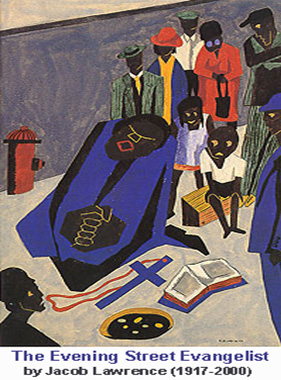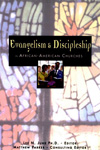EVANGELISM SUNDAY
CULTURAL RESOURCES
Sunday, August 26, 2012
Paulette Thompson-Clinton, Guest Cultural Resource Commentator
Associate Minister for Christian Education, Community Baptist Church, New Haven, CT
I. Definitions
 |
|
In the African American faith community, there are few words in the Christian lexicon that evoke the range and depth of emotion as evangelism. At the very mention of the word, visions of street corner and subway preachers may come to mind, or persistent peddlers of religious tracts walking the streets or going door to door, or one might envision packed stadiums or giant tent revival meetings. These images elicit reactions from discomfort and disdain, to passion and enthusiasm, and countless feelings in between. The question is, why would a concept that is at the very heart and soul of the Christian faith stir up such disparate emotions? For starters, there is not one clear definition of “evangelism” upon which we all definitively agree. Thus, we interact with this term from our own individual social, religious, cultural, ethnic, and political locations. This sets us up for disagreement at best; at worst, it is preparation for heated debates and hostility on multiple levels by church folks. For the purposes of this unit, I would like to propose a working definition of evangelism which may help us to forge common ground upon which to build. |
We begin with a basic dictionary definition. According to the American Heritage Dictionary, evangelism refers to “the zealous preaching and dissemination of the gospel, as through missionary work.”1 Gospel, of course, refers to the teachings of Jesus Christ, as revealed in the Holy Bible; in Christian circles gospel is often referred to simply as “good news.” The second definition states “militant zeal for a cause.” From these definitions, it is easy to understand why some might be turned off. After all, “zealous preaching,” “missionary work,” and “militant zeal” are phrases loaded with connotations, and most are not positive. Members of different sectors of the African American community, including church-going folk and people who profess to be Christians (note that these are not necessarily the same group of people), are likely to have strong reactions to each of these phrases.
Exploring the derivation of the word proves illuminating. The word evangelism is derived from the word “evangel,” which originates from the Greek word euangelion, meaning “good news,” or euangelos, meaning “bringing good news” (eu=good and angelos=messenger). Thus, evangelism means “bringing good news.” From this information, one can easily see how the word evangelist came to be, and why the four Gospel writers (Matthew, Mark, Luke, and John) who chronicled and recorded the life and times of Jesus Christ are known as evangelists—as are Christian preachers or missionaries today who engage in the act of bringing the good news of Jesus Christ. For those of us inside the church—pastors, preachers, ministers, and teachers, or simply long-time active members—what is meant by the good news of Jesus Christ ought to be self-evident. But is it? Furthermore, is this even relevant if evangelism is meant to bring the good news of Jesus Christ to those who have ostensibly not yet heard it—namely, those outside the Church? After all, it is no longer news if one has heard it before!
II. Evangelism Questions
Allow me to pose four questions which will help shape the rest of this discussion as we seek to shed light on evangelism in today’s world. 1) Who is called to evangelize? 2) To whom are we called to evangelize? 3) How are we called to evangelize? 4) Exactly what is this good news that we are called to share?
 |
|
The focus Scripture for this unit is Ezekiel 2:1-7, and it helps to lay the foundation for our task as we answer the questions posed above, starting with who the evangelist is and to whom we are to evangelize. The prophetic mandate is clear in verse 7: “You shall speak my words to them.” The prophet is speaking to us; this is unambiguous. The key message from this passage as it relates to evangelism is encapsulated in the following phrases, each of which occur at least twice in these seven verses: “Whether they hear or refuse to hear” (repeated twice) and “they are a rebellious house” (repeated three times). |
| The prophet is also clear about whom we are to evangelize, and his message that those who are receiving the message are impudent, stubborn rebels, whom he likens to briers, thorns, and scorpions is not a comfortable one. There is no welcome mat laid out for us, no beautiful floral arrangements—and these descriptions of what conditions await us do not move us to flock to the task at hand. Spending time among thorns and scorpions results in getting pricked and stung; no wonder many of us are reticent or afraid to evangelize—we are not prepared to face the pain that seems to inevitably come with the territory. |
Our territory is the United States of America in the year 2012, and it surely fits the description given by the prophet Ezekiel in the given passage. One need only substitute the word “America” for “Israel” in verse 3 and one is crystal clear that the Lord is speaking directly to us, just as God was speaking to the people of Israel for whom the words were originally written. The Bible was written over 2000 years ago, in an age drastically different from today in many significant respects.
Our communication systems, technology, infrastructure, cultural norms, and typical family units are all worlds apart from those in biblical antiquity. So although the core message to be disseminated is the same, and has the same purpose, is it reasonable to expect that the means of dissemination that were used 2 millennia ago could also be used today to the same end? The answer is no, and this gets to the heart of the “how” question. But the fourth question posed above is where we will next turn, because without the essential ingredient—the meat of our evangelistic message—we have nothing to say; in fact, we have no reason to speak at all.
III. Evangelism, The Expanded Definition—Beyond Saving Souls
Numerous definitions of evangelism are afloat in the American culture. It is probable that most of us have heard evangelism defined as “saving the lost,” “witnessing to the unsaved,” or “saving souls,” among others. For our purposes today, I propose that we go beyond these over-used phrases whose meaning is often limited to those who have grown up in church and are still there, have grown up in church and left, or those who run far away at the first hearing of a religious message. Since my evangelistic field is filled with people who do not belong to any of these groups, this insider language is not helpful. Out in the marketplace of life, where we must go if we want to reach people, folks are not walking around talking about salvation, sin, repentance, or eternal life. They are talking about jobs, their kids’ education, how to make ends meet in this tough economy, problems in their relationships, and the health care challenges of members of their family. They are not concerned about going to hell when they die; they are living in hell here and now. If our evangelism does not touch people in the places in their lives that need saving, we can talk all we want about God’s saving grace but we will end up talking only to ourselves. If people do not understand our words, they will tune us out, and our message will fall on deaf ears. While we are called to evangelize whether we are heard or not, for maximum reach being heard is preferable!
In order to effectively evangelize, we need a practical, clear, and universally understood definition of what evangelism is. James Stallings defines evangelism as “the activity in black churches and their mission organizations of communicating God’s saving and liberating activity among men and women; calling them into community with other Christians for freedom, growth, and wholeness.”2 Stallings’s words meet people where they are on the journey of life: in community; seeking freedom, growth, and wholeness; in search of liberation from all that binds us. This is the language spoken in our communities today and it represents real situations of persons we know and love.
Frequently we talk about the gospel as the “good news of Jesus Christ.” But to those outside of Christian circles, what does this mean in concrete, human terms? In Christian Education as Evangelism, Norma Cook Everist offers a very powerful and practical explanation of the good news of Jesus Christ:
If the human problem is guilt, the good news is that God through Jesus Christ forgives. If the human problem is brokenness, the good news is that Jesus makes us whole. If the human problem is alienation, the good news is that God reconciles and restores relationships. If the human problem is being lost, the good news is that the Good Shepherd looks for and finds the lost. If the human problem is death, Jesus Christ has brought new life. If the human problem is judgment, the good news in Jesus Christ is unconditional acceptance. If the human problem is bondage, the good news is Jesus brings freedom.
Everist’s litany contrasts the good news of Jesus Christ with particular conditions that all human beings have experienced at one point of their lives or another, and she does so in everyday language that is accessible to everyone—whether they have ever been inside a church or not.
Evangelism can only succeed when it connects a life rooted in Jesus Christ with the life persons are living each day at home, school, or work. Althea M. Brown’s definition of evangelism as “the linking of human life to the story of Christ Jesus”4 elucidates this point. The gospel message must be relevant to people’s lives in the here and now for them to be interested in learning more. The church must offer something that is clearly different from, and better than, what the world is offering. Otherwise, why leave the world for the Church? Noted Harlem minister, the late Rev. Robert Preston Washington stated that “the best in black Christian faith knows no distinction or contradiction between the gospel and the development of caring ministries. Sociological reality dictates a holistic gospel.”5 In other words, Washington is making plain the connection between social problems and spiritually based solutions; the reality is that we are all connected in mind, body, and spirit. Good news is best received when it is an obvious antidote to the bad news that so many of our communities are plagued with on a daily basis.
In African American culture, the value of community has always been strong. It is common knowledge that historically the Black Church has occupied a central role in the community. As this society grows ever more fast-paced, technology continues to focus on individualism and the needs of the community get put on the back burner. The result is that the previously close-knit fabric of the African American community continues to fray, and the church has lost its place of prominence in the heart of our community. This cultural and societal phenomena actually increases the need for the transforming work of the Church. To this end, Womanist theologian Delores Williams hones in on the goal of evangelism as “community-building” with these words: “the goal of this community building is to establish positive quality of life—economic, spiritual, educational—for black women, men and children.”6 Jesus’ words to us in John 10:10 resonate loudly here: “I came that they may have life, and have it (more) abundantly.” In an age where abundant life is more and more measured by the prevalence of the material, we must return to the superiority of the spiritual, and effective evangelism is the key to accomplish this.
In his excellent book on African American church growth, Carlyle Fielding Stewart III outlines 12 principles for prophetic ministry, including three on prophetic evangelism. They are: “Proclamation of the Good news, Propagation and communication of the message, and Participation open to all.”7 For Stewart, proclamation entails “...reclaiming the lives of God’s people through consistent belief and action which calls for the actualization of faith through the positive transformation of individuals and communities.”8 Once more, we see the intimate connection between the power of faith to change circumstances in our daily lives; this is the crux of the evangelistic message.
Finally, it cannot be overstated that evangelism is a process rather than a one-time occurrence. Louis R. Jones indicates that evangelism is a connected series of the following steps: Reach Out, Connect, Invitation, Commitment, and Nurture.9 Perhaps the most important step in this list is the last one, nurture. Nurturing persons who have newly come into the Christian faith is critical to their lifelong growth and development as a Christian as well as our own, as we strive to bear fruit and be the light of Christ on our spiritual journey.
IV. Evangelism in a TGIF World: Technology Reigns
Last year, I heard the Rev. Dr. Leonard Sweet speak. Sweet is a prolific author, preacher, and scholar who serves as the E. Stanley Jones Professor of Evangelism at Drew Theological School in Madison, New Jersey, where I attended seminary. The essence of his message was that technology leads the way in the 21st century world, and in particular, today’s children and youth are hooked on technology even before they can read. Sweet contends that if the church plans on living into the 22nd century, it had better get with the technological program or be left behind. “TGIF” in Sweet’s vocabulary stands for Twitter, Google, Internet, and Facebook. Today, virtually every single one of our information needs can be filled via technology; it has become the principal mode of information dissemination in 2012, and there appears to be no turning back. Sweet believes that churches who are not on the cutting edge of using technology to share their messages are missing a golden opportunity. He suggests that worshippers be encouraged to take notes on their cell phones, laptops, or tablets during the sermon, and then be allowed to instantly tweet, e-mail, or instant message what they are hearing and learning to their friends who are not present. He even went as far as to suggest that a screen be put up in the sanctuary to show the comments in real time. This may be far too radical a suggestion for most pastors today, but the point is that Jesus is calling us to use radical ways to reach people with his radical message of acceptance, transformative love, hope, and healing. Consider this message currently on a website advertising Sweet’s upcoming appearance at a conference:
We live in a fast paced culture where the world is literally at our fingertips. How does God’s plan fit into the realm of sound bites, video clips and comments? Can we shuffle through the status updates to find the state of our hearts? Can the blips and blogs get us back to the Bible?
This message speaks directly to the TGIF-er in language that she or he understands instantly.
Along with music, technology is the premiere way to reach young people of today on any subject, and religion is no exception. According to an online article in Lausanne World Pulse, 85% of young people visit a church’s website as part of their process of deciding whether they will visit the church in person.10 Churches who are already taking full advantage of the vast array of online resources such as interactive websites, live-streaming, chat rooms, YouTube channels, podcasts, blogs, etc. are already far ahead of the game than churches who are not. If the church does not fully embrace technology in all its forms and harness it as a key evangelistic tool, the average church will not survive. Young people will continue to surf not just the internet, but the entire technological wave. By itself, the technological wave is devoid of spiritual teachings, and the implications of this statement for tomorrow’s world are devastating.
V. Brief Musings on Evangelism from Africa to America and Back
In a conversation with a colleague, it came up that in history, people of African descent have frequently been the victims of evangelization. Juxtaposed with the commonly held idea that evangelism is done for the purpose of saving persons who are spiritually lost, this was a provocative comment. In a 1978 article entitled “Towards a Black Evangelism,” scholar, preacher, and historian Henry H. Mitchell cogently connects the dots between the religious history of our African ancestors and the religious context of the late 20th century. According to Mitchell, “African ancestors of black Christians today were...cultural and individual giants,...and they stole Christ and adapted a profoundly Christian faith far ahead of the white folks’ schedule.”11 His words are enough to cause us to rethink the relationship between evangelistic Christianity and chattel slavery. Mitchell asserts that in West African culture, religion is a pervasive part of everyday life; religion does not live in separate containers from the rest of life as it typically does in the United States. I witnessed this first-hand during the three years I lived in Benin, West Africa from 1998–2000. Religion was indeed part of the fabric of daily life, and adherents of Christianity in all its forms—Catholicism and numerous Protestant denominations, African Traditional Religion, and Islam lived and worked together in ways that appeared far more integrated and harmonious than I had found to be the case here. Mitchell affirms: “The life style was such that God and religion were in everything; planting and harvesting yams, birth and death, and every other process of life.”12 This is a far cry from the de facto separation of church and state here in the United States, resulting in what feels to some like surgical removal of religion from the general culture.
Mitchell informs us that the Christian faith among enslaved persons grew quickly during the 18th century—the height of chattel slavery, due to the “overlap in cultus between African and frontier spirituality.”13 He maintains that the relation of white religion to black religion was a reciprocal one, each having influenced the other. The racial history of America makes it impossible to talk about evangelism without alluding to racism, but Mitchell compels us to go beyond this point to see that the black religious experience became a place where members could gather to reaffirm their connectedness as members of God’s family.14 Moreover, the church was a place where concrete needs could be met: the hungry would be fed; the sick and imprisoned would be visited; the bereaved comforted. Taken to its logical conclusions, Mitchell’s vision of black evangelism is that the people “must know and practice the faith so well as a family of God that those outside will hear of it and come asking what they can do to be ...admitted.”15 This is indeed a wonderful vision, one that manifests Jesus’ words in Matthew 25:35-36: “...for I was hungry and you gave me food, I was thirsty and you gave me something to drink, I was a stranger and you welcomed me, I was naked and you gave me clothing, I was sick and you took care of me, I was in prison and you visited me.”
Today, African Christianity in sub-Saharan Africa is rapidly growing, specifically Pentecostal and Charismatic churches.16 This is due to many factors, including the influence of American televangelism, and the indigenous elements of African culture and expression that lend themselves to these highly expressive forms of worship. What is clear is that persons throughout the African diaspora have come to know Jesus Christ for themselves, not through the eyes of anyone else. To paraphrase Acts 1:8, they have received power from the Holy Spirit, and are Jesus’ witnesses to the ends of the earth. Someone is clearly listening.
Evangelism today requires us to be “prophetic witnesses in an anti-prophetic age”,17 says Otis Moss Jr. Evangelism today requires faith, confidence, clarity, and purpose. Evangelism today requires us to be rooted firmly in the liberating and transforming teachings of the Bible, especially the teachings of Jesus Christ. Evangelism today requires us to be open to the countless ways there are to connect with our brothers and sisters who have yet to fully receive the good news—freedom from oppression, new life where there was death, and sight for the spiritually blind. We end with the divine mandate Jesus gave to spread the good news to all, the Great Commission (from Matthew 28:18-20): And Jesus came and said to them, “All authority in heaven and on earth has been given to me. Go therefore and make disciples of all nations, baptizing them in the name of the Father and of the Son and of the Holy Spirit, and teaching them to obey everything that I have commanded you. And remember, I am with you always, to the end of the age.”
VI. Resources for Educating Your Congregation on Evangelism
Education is pivotal to the success of a church’s evangelism efforts. The evangelism education mission of every church must have the full support of the pastor and should ideally involve the entire congregation, starting with the associate ministers and lay leaders. Following is a list of actions a church can take in order to launch an effective evangelism education program, which will form the foundation of an effective evangelism ministry. The first step is to make evangelism a core part of your church’s mission and action by holding intensive evangelism training with the ministerial leadership and key lay leaders.
A helpful checklist and summary of prophetic evangelism principles is a great resource for beginning this process, and can be found in African American Church Growth by Carlyle Fielding Stewart III.18 Another useful resource is Evangelism: Go Make...(Matt. 28:19) by Althea M. Brown.19 It is practical and accessible and adaptable to different theological contexts.
Practical Steps to Launching an Evangelism Ministry
Internal Evangelism
- Pray regularly as a church and seek the guidance of the Holy Spirit;
- Hire (if possible) a trained person to lead evangelism efforts for your church. At a minimum, assign a trained volunteer to lead your evangelism efforts. The evangelism efforts of all churches will always be off and on unless there is a person totally responsible for keeping them going.
- Enroll the entire church. Invite each member of the church to commit to making evangelism a core value;
- Establish a Lay Evangelism Team;
- Encourage all ministries to devote a month to evangelism education and activities to immerse the whole church in it;
- Set concrete goals within each ministry for evangelism;
- Pastors must preach series on evangelism and lead Bible studies on evangelism;
- Offer evangelism education and training at all levels on a regular basis, including classes on dispelling evangelism myths;
- Offer training in communication and listening skills; and
- Identify different evangelistic activities at various levels:
- Inviting people to church;
- Evangelizing with one’s life by showing the fruits of the Spirit (Galatians 5:22-23);
- Distribute written materials that lead people to a website;
- Use Technology: Facebook posts, Twitter, blogs, etc.
External Evangelism
- Reach out to the community often;
- Have the head of your evangelism efforts design a community outreach plan with the participation of the church. Use surveys, talk to ministry leaders, talk to those at churches with successful external evangelism, etc.;
- Identify different groups with which to connect: family members, co-workers, members of clubs and professional organizations, bank clerks, grocery store workers, etc.;
- Have a summer street fair and/or back-to-school block party;
- Go door to door to invite neighbors to a major community event such as a school-board meeting, leaving cards or flyers;
- Have different ministries sponsor events such as Game Night, Movie Night, Basketball Night, Learning How to Make a Video Night, Beauty Make-Over Night, Financial Health Night; etc.;
- Engage in community-wide projects such as cleaning up neighborhoods, visiting elderly, delivering food or baby supplies, etc.
- Embark on a Spiritual Gifts Campaign; help people develop their spiritual gifts in tandem with developing their evangelism skills;
- Use members’ artistic gifts as evangelistic tools (music, visual arts, drama, poetry, etc.);
- Do role playing with people modeling faith-sharing conversations, focusing on good listening techniques as well as faith-sharing techniques; and
- Use Technology: Facebook posts, Twitter, blogs, etc.
Evangelism education must be comprehensive enough to include effective ways to connect the gospel story with the human story and to help people practice good communication skills—including listening; validating; engaging deep questions about God, faith, suffering, and life; considering how to respond to persons who have been hurt or wounded by the Church in the past; and the acknowledging people’s stories.
VII. Storytelling and Evangelism
 |
|
Evangelism is about telling stories, and storytelling is a tried-and-true way for us to learn. From the Soap Operas of yesteryear, to the sitcoms and dramas of the ‘70s and ‘80s, to the epic of reality television shows in the 21st century, we LOVE stories! Telling stories is perhaps the most central act of human communication; it begins as soon as we come out of our mothers’ womb. We tell stories to our babies and children: stories of who we are, stories of our lives, stories of what we want them to become. Griots were masters of storytelling in the African culture honored for their storytelling gifts. When we share our own personal story of |
| how being in a loving and committed relationship with our Lord is the reason why we sing and the key to our having gotten through all of the trials in our life, people listen and are moved! James Stallings20 reminds us that our sacred text, the Holy Bible is one long story—the story of God’s redemptive activity on behalf of those God created to be like God—human beings. The Gospels are full of stories including stories told by Jesus that speak to our hearts, minds, and souls. Jesus was a master storyteller too and the stories he told are those we have been telling our children ever since. |
VIII. Additional Resources on Evangelism
- Visit the Urban Ministries website at www.urbanministriesvbs.com to see their Summer 2012 Vacation Bible School Curriculum, “Fishin’ on a Mission with Jesus.”
- See the Evangelism Institute’s website; it has practical information that is easily adaptable for any church context. Online location: www.theevangelisminstitute.org.
Audio Visual Resources
- SermonSpice.com features a somewhat countercultural video of a young African American man inviting his elderly white neighbor, Mrs. Edwards, to go to church with him. The young man is jamming to the beat of the music playing loudly in what we assume to be his car, but it turns out that it is coming from Mrs. Edwards’s boom box. The video is an example of crossing cultural and age boundaries to invite friends to church, and demonstrates the power of a personal invitation and persistence as well. Online location:
http://www.sermonspice.com/Christian-Videos-and-Clips-LPadwMY?gclid=CJLA9-7PyK0CFUOo4AodEUj9hQ (accessed 12 February 2012)
- Pictures and graphics are helpful to use on flyers and other literature inviting people to evangelism training sessions or seminars. One featured at Cyberbretheren.com illustrates a fishing line in water with fish gathering around it. It is a visual representation of Jesus calling his disciples to fish for people (Mark 1:16-20). Online location:
http://cyberbrethren.com/2010/04/19/lutherans-and-evangelism-have-we-lost-our-voice/ (accessed 12 February 2012)
IX. Songs That Speak to the Moment
The five songs listed below speak to several of the points made in the previous sections on evangelism. The first song is for young children and is based on Jesus’ first fishing expedition for people, as recorded in the first chapter of the Gospel of Mark 16–20. The second song comes to us from Lectionary liturgist Reverend Nolan Williams. The song which is titled, “Hiding out in the Pews” is a particularly poignant message of the Church being the right place of refuge and release for those who feel burdened by life. Then the familiar hymns speak to the certainty felt by those who have committed themselves to Christ, or the willingness to present oneself as one who will go and do the work of sharing the message with those who need to hear it. The hymns in particular all contain familiar words to those who are long-time church members. The tunes are catchy as well, so that even people who do not know them well can catch on to them quickly.
It is also necessary to introduce completely new contemporary music to the masses of people who have no experience with church music. For all of the contemporary music you need for evangelism activities, see today’s thorough and thoughtful music and worship unit prepared by Ms. Michelle Riley Jones, Lectionary liturgist.
Go Fish, Go Fish - A song for young children ages 1–7
One day by the water
Out on the deep blue sea
The fish just weren’t biting
The nets were so empty
Then Jesus came and He said, O my
Cast your nets to the other side
And, go fish, go fish
Fishing for the Lord
Chorus
Go fish! Go fish! People now
Go fish! Go fish! People now
Go fish! Go fish!
Fishin’ with Jesus, believe us
People need the Lord today
So cast the gospel net their way, and
Go fish! Go fish!
Fishin’ for the Lord
Well that day by the water
His men were so amazed
The nets were full and breaking
Then they heard Jesus say
Follow me, I’ve a job to do
So they followed Him, I guess they knew
They would go fish, go fish
Fishin’ for the Lord
Repeat chorus21
Hiding Out in the Pews
I came to this church dejected and lost. In a crowd I was trying to hide.
All the burdens I bore weighed me down like a cross.
There’s a part of me that wanted to die.
But the more that I came, and the more I believed,
Something miraculous occurred in my life.
Hiding out in the pews is where Jesus met me. Now I’m healed because of Christ.
Did you come to this church dejected and lost? In a crowd are you trying to hide?
Do the burdens you bear weigh you down like a cross?
Is there a part of you that wishes to die?
Well, you’re in the right place. You got here at the right time.
There’s a miracle with your name in mind.
Hiding out in the pews, let Jesus meet you. Let Him heal and mend your life!
Jesus will meet you right where you are. But Jesus, He won’t leave you stranded afar.
He’s able to lift you where’er you may be, if you have the faith to believe!
You’re in the right place. You got here at the right time.
There’s a miracle with your name in mind.
Hiding out in the pews, let Jesus meet you. Let Him heal and mend your life!22
Traditional Hymns
Here I Am, Lord
Verse 1
I, the Lord of sea and sky, I have heard my people cry.
All who dwell in dark and sin My hand will save.
Finest bread I will provide till their hearts be satisfied.
I will give my life to them. Whom shall I send?
Refrain
Here I am, Lord. Is it I, Lord?
I have heard You calling in the night.
I will go, Lord, if You lead me.
I will hold Your people in my heart.
Verse 2
I, the Lord of snow and rain, I have borne my people’s pain.
I have wept for love of them. They turn away.
I will break their hearts of stone, Give them hearts for love alone.
I will speak my word to them. Whom shall I send?
Refrain
Verse 3
I, the Lord of wind and flame, I will tend the poor and lame.
I will set a feast for them. My hand will save.
Finest bread I will provide Till their hearts be satisfied.
I will give my life to them. Whom shall I send?
Refrain23
I Am a Living Testimony
I am a living testimony
Should have been dead and gone
But Lord you let me live on
I am a living Testimony
I thank the Lord I’m still alive!24
I Have Decided to Follow Jesus
I have decided to follow Jesus,
I have decided to follow Jesus,
I have decided to follow Jesus,
No turning back, No turning back!
Though no one join me, still I will follow,
Though no one join me, still I will follow,
Though no one join me, still I will follow,
No turning back, No turning back!
The world behind me, the cross before me,
The world behind me, the cross before me,
The world behind me, the cross before me,
No turning back; no turning back!25
X. Recommended Books
 |
June, Lee N., and Matthew Parker, eds. Evangelism & Discipleship in African American Churches. Grand Rapids, MI: Zondervan, 1999. |
 |
Reese, Martha Grace. Unbinding the Gospel: Real Life Evangelism. St. Louis, MO: Chalice Press, 2007. |
 |
Walton, Jonathan L. Watch This! The Ethics and Aesthetics of Black Televangelism. New York: New York University Press, 2009. |
Notes
1. Online location: AmericanHeritageDictionary.com
2. Stallings, James O. Telling the Story: Evangelism in Black Churches. Valley Forge: Judson Press, 1988. p. 19.
3. Everist, Norma Cook. “Learn to Share Christ in the Languages of People’s Daily Lives.” Christian Education as Evangelism. Norma Cook Everist, ed. Minneapolis: Fortress Press, 2007. p. 128.
4. Brown, Althea M. Evangelism: Go Make…(Matt. 28:19). Bloomington, IN: AuthorHouse, 2010. p. 45.
5. Washington, Preston Robert. God’s Transforming Spirit: Black Church Renewal. Valley Forge, PA: Judson Press, 1988. p. 93.
6. Williams, Delores S. “Womanist Theology: Black Women’s Voices” in Black Theology: A Documentary History. James H. Cone and Gayraud Wilmore, eds. Maryknoll, NY: Orbis, 1993. p. 269. See also Brown, Michael Joseph. “The Gospel of Matthew.” True to Our Native Land: An African American New Testament Commentary. Brian K Blount, ed. Minneapolis, MN: Fortress Press, 2007. p. 117.
7. Stewart, Carlyle Fielding III. African American Church Growth: 12 Principles for Prophetic Ministry. Nashville, TN: Abingdon Press, 1994. p. 115.
8. Ibid. p. 123.
9. Jones, Louis R. Evangelism in the African American Community: An Evangelism Tool for Today’s Church. New York: iUniverse, Inc., 2003. pp. 20–26.
10. Emiston, John. “Ten Ways the Internet Is Changing Evangelism and Missions.” Lausanne World Pulse. www.cybermissions.org. Articles on Cybermission—Getting the Idea. 10 January 2012.
11. Mitchell, Henry H. “Towards a Black Evangelism.” The Journal of Religious Thought 35.1 (1978): 56.
12. Ibid., p. 57.
13. Ibid., p. 61.
14. Ibid., p. 63.
15. Ibid., p. 66.
16. Anderson, Allan. “Evangelism and the Growth of Pentecostalism in Africa.” Centre for Missiology and World Christianity. University of Birmingham, UK.
17. Moss, Otis Jr.
“A Prophetic Witness in an Anti-Prophetic Age.” Blow the Trumpet in Zion! Global Vision and Action for the 21st Century Black Church. Iva E. Carruthers, Frederick D. Haynes III, and Jeremiah A. Wright Jr., eds. Minneapolis, MN: Fortress Press, 2005. pp. 126–130.
18. Stewart, Carlyle Fielding III. African American Church Growth. pp. 142–143.
19. Brown, Althea M. Evangelism: Go Make…(Matt. 28:19). Bloomington, IN: AuthorHouse, 2010.
20. Stallings, James O. Telling the Story: Evangelism in Black Churches. Valley Forge: Judson Press, 1988. p. 15.
21. “Go Fish, Go Fish.” By Stephen Elkins. From the combination book/CD 100 Bible Stories, 100 Bible Songs. Nashville, TN: Thomas Nelson, 2005.
22. “Hiding Out in the Pews.” By Nolan Williams Jr. inSpiration. Washington, D.C.: NEWorks, 2009.
23. “Here I Am, Lord.” By Dan Schutte. African American Heritage Hymnal. Chicago, IL: GIA Publications, 2001. #567
24. “I am a Living Testimony.” Traditional.
25. “I Have Decided to Follow Jesus.” Ascribed to an Indian prince. African American Heritage Hymnal. #400
|